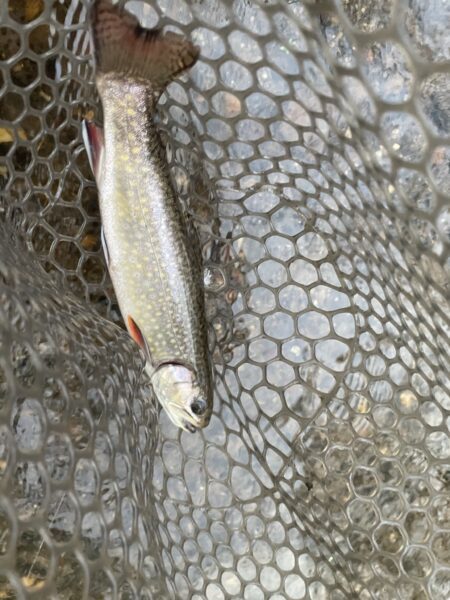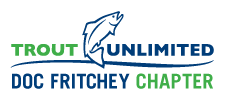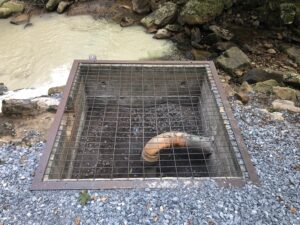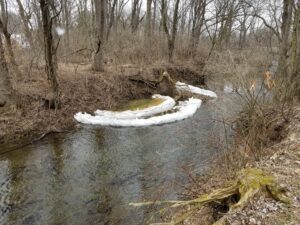One of the largest conservation projects in the history of the Doc Fritchey Chapter is slowly coming to fruition in southeast Lebanon County. Hammer Creek, part of the Hammer Creek Watershed and situated on a 1,000-acre farm owned by the Barry brothers, is currently under the expert leadership of former chapter president Russ Collins and Dr. James Suleski, a current member of the chapter’s board of directors.
History

Back in early 2019, a couple of DFTU members and a similar number of Donegal Chapter members started talking about an effort to restore the upper reaches of Hammer Creek. Those conversations resulted in a working group — the Hammer Creek Restoration Group — which has slowly and surely, despite a global pandemic, created a working plan for a major streambank restoration project on Hammer Creek, an expansive watershed with a drainage area of 15.62 square miles, running from north of Schaefferstown in Southeastern Lebanon County to its confluence with Cocalico Creek in Lancaster County.
Almost all of the stream in the upper sections is privately owned and the group has found willingness on the part of almost all landowners for the restoration efforts the working group is currently designing. Further downstream of this initial project area is public water, annually stocked by the PA Fish and Boat Commission’s “white fleet.”

Note:
As the working group has met with landowners to determine interest in this project, and walked and surveyed the meandering stream, the group has come to realize that in some significant sections of the creek there are thriving populations of native brook trout, and it’s clear that a restoration effort in the spring-fed sections of the upper portions of Hammer Creek could result in major improvements to brook trout habitat.
Our consultant, Rocky Powell of Clear Creeks Consulting, has identified a small spring that feeds the main stem of Hammer Creek on the Barry Farm. Rocky has suggested this spring presents the opportunity to create a brook trout nursery in Hammer Creek, which raises a fascinating possibility; that we can restore Hammer Creek to help the brookies better cope with the currently existing stressors on the watershed and mitigate them as much as possible.
The spring channel Rocky Powell has designed will serve a triple purpose of being young-of-the-year habitat, spawning habitat, and summer thermal refuge habitat that Hammer Creek brook trout can use even if the main stem of the Hammer gets too warm during the summer. The design and permitting for this “special project” will begin once we receive notice of our grant being awarded.
Photo: A large native brook trout caught and released by a local school teacher, Will Maza.
Assessments Begin
The working group started its efforts on Hammer Creek by engaging TU National’s habitat coordinator, Shaun McAdams. With Shaun’s help, the group began a full-scale habitat assessment process.
The group divided the watershed into three sections and walked the stream and its feeders to gather data to determine the areas that were most in need of restoration. Dr. Jim Suleski spent countless hours accompanying Shaun on stream walks, many of which were during the winter.
Phase One of the assessment also pointed the working group in the direction of property owners interested in restoring the creek on their property. As they talked with these property owners, they discovered that the Pennsylvania DEP had previously completed a watershed implementation plan (called an ARP – Alternate Restoration Plan). During this initial assessment period, Shaun McAdams and Dr. Suleski identified numerous stretches of Hammer Creek with severely-eroded stream banks, wide and shallow areas with no riparian buffers, and significant livestock impact.
Russ Collins has been actively engaged with the affected property owners and has created significant rapport with these owners (three of which have signed landowner agreements) – to the point where we are confident this Hammer Creek project, once funded (and we think funding is imminent), will be able to begin construction in the fourth quarter of 2021. One of the key sections of Hammer Creek that needs immediate attention is on the farm owned by the Barry Family: three hardworking, conservation-minded brothers that run a successful farming operation on about 1,000 acres of prime Lebanon County farmland.
Over the past two years, Russ Collins and Jim Suleski have walked the farm with the Barry brothers, explaining how the Doc Fritchey Chapter operates and explaining in detail how the chapter will work with them to professionally restore the creek and the watershed. Over several meetings and lots of walks about their farm, a basic streambank restoration concept was developed, which resulted in the submission of a comprehensive funding proposal.





Acknowledgements
Thanks to the efforts of Dr. Jim Suleski and Russ Collins, the Barry brothers have grown to trust our chapter’s interest in working with them to restore a large portion of Hammer Creek as it winds through their farm. Even though several for-profit-restoration companies have approached the Barry brothers, they have decided they want to work with our Hammer Creek Restoration Group (and take a significant number of acres permanently out of production) to complete Phase One of what promises to be a multi-year streambank restoration project within the Hammer Creek watershed.
Obviously, we are at the beginning of a major effort to restore Hammer Creek, and there are many miles of stream to go. For this initial grant application submission, we have engaged Clear Creeks Consulting and Ecosystem Planning & Restoration as our project design consultants.
Interested in Helping?
If you’re interested in learning more about this project, or how you can help volunteer, please contact Jim Suleski by email at jims@dftu.org and Russ Collins by email at russ@dftu.org, or simply fill out the form, below.
Hammer Creek Volunteer Sign-up
Please fill out this short form to send a message to our volunteer coordinators. (Note: fields marked with an asterisk (*) are required.)



